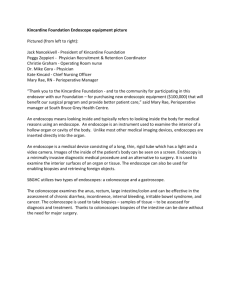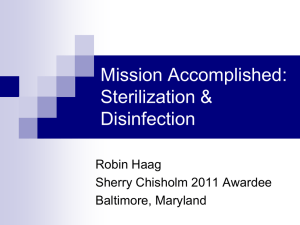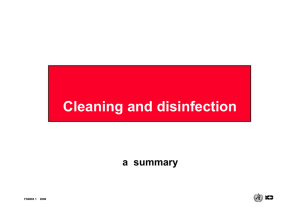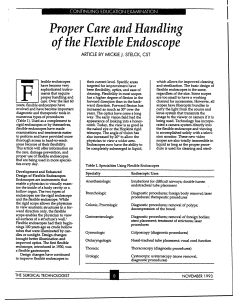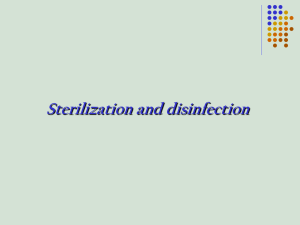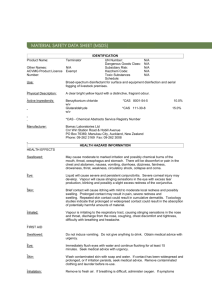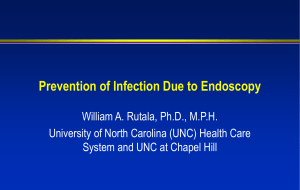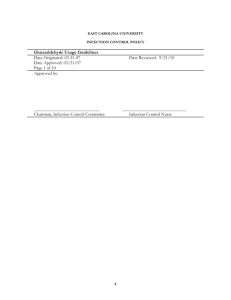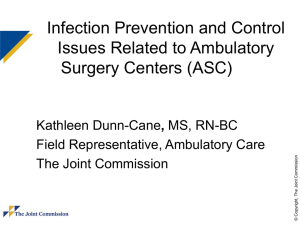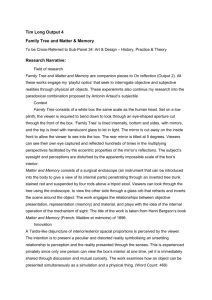High Level Disinfection of Endoscopic Equipment and Accessories
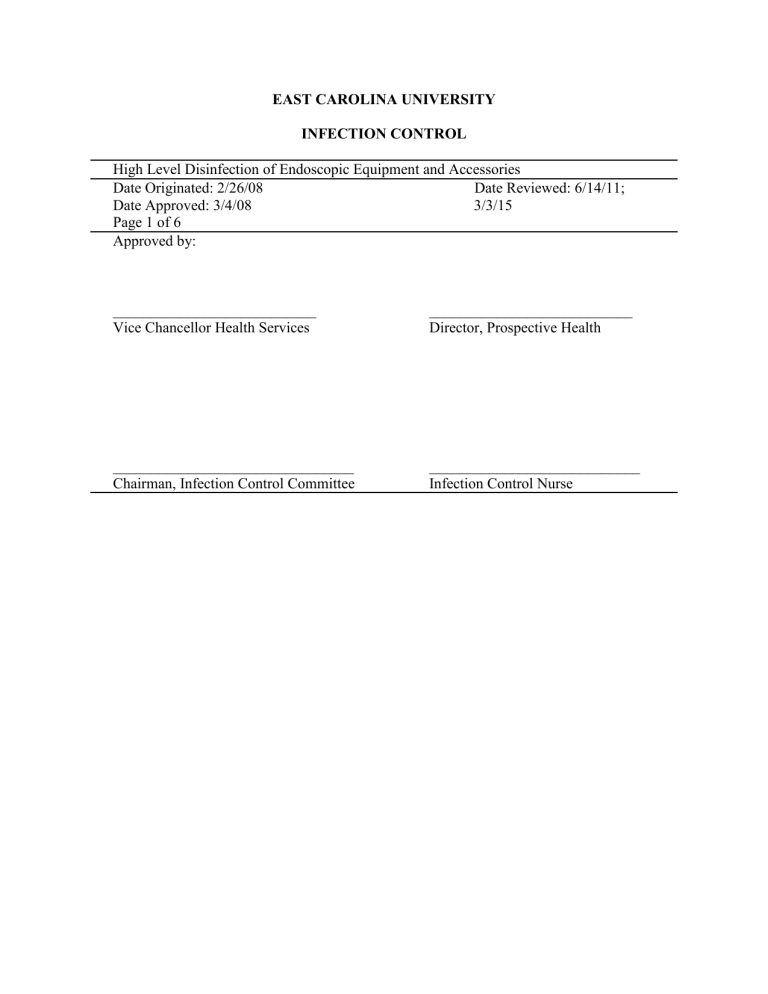
EAST CAROLINA UNIVERSITY
INFECTION CONTROL
High Level Disinfection of Endoscopic Equipment and Accessories
Date Originated: 2/26/08 Date Reviewed: 6/14/11;
Date Approved: 3/4/08 3/3/15
Page 1 of 6
Approved by:
___________________________
Vice Chancellor Health Services
___________________________
Director, Prospective Health
________________________________
Chairman, Infection Control Committee
____________________________
Infection Control Nurse
2
Policy: High Level Disinfection of Endoscopic Equipment and
Accessories
1 . Rigorous mechanical cleaning to remove organic material from the outside of the insertion tube and from the lumens of all accessible channels is imperative before disinfection or sterilization.
2 . The cleaning of endoscopes and accessories must be promptly performed with detergents and rinsed after use to prevent drying of secretions.
3 . If powdered detergent is used, care must be taken to ensure that undissolved powdered detergent granules do not block the internal channels of the instrument.
4 . Before cleaning, all channels must be irrigated with copious amounts of detergent and tap water to soften, moisten and dilute the organic debris. All detachable parts (e.g., hoods and suction valves) must be removed and soaked in a detergent solution for 10 minutes. The insertion tube must be washed with detergent solution and rinsed.
Accessible channel(s) must be brushed to remove particulate matter and the detergent solution must be suctioned or pumped through all channels to remove dislodged material.
(Channel irrigators and some automated endoscope washer/disinfectors may be useful in this step).
5 . Careful attention must be given to crevices, which are likely to harbor contaminated organic material.
6 . When cleaning an ERCP endoscope, the distal tip must be brushed with the elevator both up and down to insure that no matter is lodged in that moveable part.
7 . Detachable parts must be thoroughly cleaned with detergent. Irregular surfaces of the detachable parts must be brushed to ensure complete removal of all organic debris.
8 . The cleaning brushes must be disposable or thoroughly cleaned and receive high-level disinfection or sterilization at least daily.
9 . After mechanical cleaning, immersible equipment must be thoroughly rinsed with water.
10 . At all stages of handling, the equipment must be inspected for damage and a leak test must be performed before submerging the entire instrument. If damage is detected, the equipment must not be submerged or reused and the manufacturer must be consulted.
Endoscopes that fail leakage tests are sent to central supply for gas sterilization before being sent out for repair.
M ANUAL C LEANING OF E NDOSCOPES
1 . Follow steps 1-4 of above procedure
2 . Perform leak testing on instrument. If a leak is found, the scope must not be immersed in the disinfection solution. The scope should then be sent to Central Supply for gas sterilization before sending the instrument out for repair.
3 . Immerse instrument in tub of detergent solution. Thoroughly clean exterior of endoscope.
4 . Attach cleaning adapters to the endoscope. Soak the endoscope in the detergent solution for 10 minutes. Flush detergent solution through all the working channels of the scope (i.e. suction, air, water, elevator wire, and biopsy channel).
3
5.
After soaking for appropriate time, rinse the endoscope and removable parts thoroughly under running water to remove any residual detergent. Flush all channels with water.
6 . Purge all channels of the endoscope with air to prevent dilution of the disinfection agent.
7 . After purging with air, immerse the endoscope into a tub of disinfecting solution.
Using a cleaning adapter, fill all of the working channels of the endoscope with solution until no air bubbles are seen. Soak scope for 20 minutes in a glutaraldehyde solution.
8 . Thoroughly rinse with sterile water all surfaces and channels of the endoscope and removable parts to remove all traces of disinfectant solution.
9 . Purge all channels of the endoscope with air.
10 . Before storage, flush all channels with 70% alcohol to facilitate drying. Purge all channels with air.
11 . Dry all removable parts.
12 . Hang endoscope vertically in a ventilated closet or cabinet for complete drying.
A UTOMATED P ROCESSING
Automated machines are useful and may reduce exposure of personnel to toxic chemicals and may standardize the contact time of the disinfecting agent. These machines are designed to irrigate most channels (biopsy/suction, air/water) of the instrument. The air/water channel is the one most likely to become occluded with organic debris during use, which is particularly difficult to clean manually.
For automated processing.
1 . Meticulous manual cleaning as described previously must precede the use of automated machines.
2.
The channel for the elevator must still be cleaned and disinfected manually.
3 . The operator must carefully set the timer on the pump to select appropriate cycle lengths.
4.
The machine must be equipped with a basin (holding tray) to allow immersion of the insertion tube and the umbilicus (light guide connector).
A
GENTS
R
ECOMMENDED FOR
H
IGH
L
EVEL
D
ISINFECTION OF
F
LEXIBLE
E
NDOSCOPES
Please refer to manufacturer’s instructions.
1 . Alkaline Glutaraldehyde (general guidelines)
a. A 2% glutaraldehyde solution must be used.
b. Glutaraldehyde is non-corrosive to metal and does not damage endoscopes.
c. It is highly resistant to neutralization by organic soil.
d. The shelf life of activated solutions is 14 days. Chemically stabilized solutions have a shelf life (i.e., a period during which they maintain adequate glutaraldehyde concentrations) of at least 14 days and of 28 days when in-use dilution does not exceed 50%.
2.
Acid Glutaraldehyde
a 2% glutaraldehyde solution must be used.
b. Some acid solutions are more corrosive to metal.
c. Acid solutions are stable for long periods, without loss of active aldehyde groups.
4
d. A 2% solution acts as a chemical sterilant and is acceptable for high level disinfection.
3.
Hydrogen Peroxide (H202)
a. Facilitates removal of organic debris and is relatively free of toxic fumes.
b. Hydrogen peroxide can damage rubbers and plastics, and corrodes copper, zinc and brass.
c. A 6% hydrogen peroxide/0.85% phosphoric acid solution, classified as a high-level disinfectant, is acceptable for endoscope preprocessing unless incompatible with endoscopic equipment.
4 . Peracetic acid
a. A 1% peracetic acid solution has broad-spectrum activity against bacteria, fungi, spores and enteroviruses in 10 minutes.
b. Can be corrosive; however, in automated endoscope reprocessing systems, the 35% peracetic acid is diluted to a final concentration of 0.2% and a buffer and an anticorrosive agent are added. This system is designed only for reprocessing totally immersible endoscopes.
5 . Orthophthalaldehyde (e.g. Cidex OPA)
(contains 0.55% Orthophthalaldehyde)
a. Stable over wide pH range of 3-9; nonirritating to eyes and nose; requires no activation; materials compatibility with wide range of devices
b. Can be staining to skin and clothing if solution is not adequately rinsed from instrument
c. Excellent microbiocidal activity
d. Has FDA clearance for use as liquid HLD on flexible endoscopes.
T REATMENT OF THE E NDOSCOPE AFTER D ISINFECTION OR S TERILIZATION
1 . Rinsing: To prevent toxic effects of residual chemicals after disinfection, the equipment must be adequately rinsed. Rinsing must be done with sterile water. Tap water may contain contaminating organisms or residue.
2 . Drying: The insertion tube and channels must be thoroughly dried. Rinsing channels with 70% alcohol and directing compressed air through the damp lumens will facilitate drying. Drying with alcohol and compressed air must be done.
3 . Storage: Endoscopes must be stored without control valves, distal hoods, caps, etc. in place. There must be adequate space to keep the endoscopes and other equipment from coming into contact with each other.
P
ROCESSING OF
A
CCESSORY
E
QUIPMENT
1 . Items that penetrate mucosal barriers (e.g., biopsy forceps) are considered critical and therefore must be sterile before use. Biopsy forceps are heat stable and can be cleaned with an ultrasonic cleaner and steam sterilized.
2 . Because of their tightly-wound, spring like configuration, they are extremely difficult to clean mechanically and sterilization may fail if organic debris is not scrupulously removed. In general all endoscopic accessories that enter sterile tissue must either be disposable or sterilized between uses.
5
3 . Sterile water must be used to fill the bottle for endoscopic irrigation. The water bottle and its connecting tubing must be sterilized or receive high level disinfection at least daily.
Q
UALITY
C
ONTROL
1 . Disinfectant Solution: Commercial test kits are available for chlorine, hydrogen peroxide, orthophthalaldehyde and glutaraldehyde to determine whether an effective concentration of active ingredients is present despite repeated use and dilution.
2 . Routine Environment Sampling: Routine environmental and equipment sampling is not recommended.
3 . Focused Microbiological Testing: Focused testing is warranted if clinical or epidemiologic findings suggest endoscopy-related transmission of infection. Under these circumstances, culturing must be based on epidemiologic data and follow a plan that specified the specimens to be obtained for culture and the action to be taken on the basis of the results . CONTACT INFECTION CONTROL (4-3202) IF ENDOSCOPY-
RELATED INFECTIONS ARE SUSPECTED.
4 . Potential Microbiological Testing Methods : Aliquot of sterile, nonbacteriostatic, saline solution flushed through the suction and biopsy, air water, elevator and carbon dioxide channels may be quantitatively cultured to determine the adequacy of disinfection. However, few organisms will be obtained from washing alone. Brushing of the suction and biopsy channel with a sterile brush is more likely to release viable organisms attached to the inner lumen of the channel is a more sensitive sampling technique. Specimens must be inoculated onto appropriate media. The criterion of acceptability is the absence of growth of vegetative bacteria. When epidemiologic data suggest infection transmission by endoscopes, observation of the technique followed by personnel must be done.
For continuous monitoring of potential adverse events, a logbook must be maintained in the unit with a list indicating for each procedure the patient’s name and medical record number, the procedure, the endoscopist and the serial number or other identifier of the endoscope used.
5 . Reporting of Adverse Occurrences : All adverse occurrences resulting from endoscopy must be reported to the appropriate internal departments, (i.e., Infection
Control, BSOM Risk Management and Environmental Health and Safety).
F
ACILITY
S
PACE FOR
P
ERFORMING
E
NDOSCOPIC
P
ROCEDURES
1 . Space for performing procedures must be separate from space used for cleaning and disinfection or sterilization of equipment with a designated sink for hand washing.
2 . Space used for the cleaning and disinfection or sterilization must have adequate ventilation to exhaust toxic vapors and airborne pathogens. Large volume basins of glutaraldehyde must be covered with well fitting lids and consideration must be given to the installation of an exhaust hood.
3. There must be separate hand washing and utility sinks. The utility sink must be large enough to accommodate the cleaning and rinsing of endoscopes and accessories.
4 . When machines are used for disinfection, the area must be designed with adequate space and appropriate utilities specific to the machines being used.
5 . There must be adequate space for the storage of chemical sterilants, some of which have special handling requirements as hazardous materials.
6
6 . Co-mingling of contaminated with clean equipment must be avoided.
7 . Closets or cabinets used for drying and storage must be constructed of materials that can be cleaned easily.
8 . Endoscopes must not be stored in foam-lined cases since the foam lining is impossible to clean. Endoscopes must be stores in a manner that will protect the endoscope while minimizing the potential for residual moisture accumulation.
9 . Personal protective equipment (gloves, eyewear, respiratory protective devices, etc.) must be readily available and must be used to protect workers from exposure to infectious agents HIV, HBV, M. tuberculosis, etc., as well as toxic chemicals.
10. Staff is prohibited from eating and drinking in the procedure or utility rooms.
P
ERSONNEL
E
DUCATION
1 . Training of new endoscopy cleaning personnel must include close observation until competency is demonstrated.
2 . Personnel must be educated about the hazards of exposure to toxic chemicals, such as glutaraldehyde.
3 . Components of education must include that:
Glutaraldehyde is irritating to the skin and can cause allergic contact dermatitis.
Exposure to glutaraldehyde vapor at 0.3 ppm may result in irritation of the eyes and nasal mucosa.
The safe ceiling limit on the level of glutaraldehyde in the air is considered to
be 0.2 ppm.
Other symptoms of exposure to toxic levels include rashes on hands, eczema, nasal and throat irritation, nausea and headache.
4.
Ultrasonic cleaning that raises the temperature of the immersion tank and increases the activity of the disinfectant may also increase staff exposure to glutaraldehyde. It is therefore critical that areas where glutaraldehyde is in use be extremely well ventilated and that exhaust hoods be installed for tubs, wherever possible.
5 . Endoscopy personnel must understand the risk of infection with agents such as M. tuberculosis, HBV, HIV, Herpes simplex and enteric pathogens. Personnel must know that a patient’s infectious status is often unknown at the time of endoscopy.
6 . For all procedures, personnel must wear protective attire (including gloves, masks, eye protection and moisture-resistant gowns or aprons) as needed to protect themselves from exposure to blood and body fluids. These items must be readily accessible in the endoscopy area.
7 . Personnel exposed to blood and body fluids must complete an Incident Report and take the report to Prospective Health.
8 . All endoscopy personnel who are susceptible to HBV infection must be immunized with Hep B vaccine.
